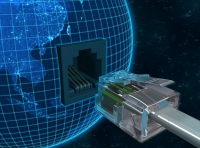








DSL (Digital Subscriber Line) is a technology for bringing high- bandwidth information to homes and small businesses over ordinary copper telephone lines. xDSL refers to different variations of DSL, such as ADSL, HDSL, and RADSL. Assuming your home or small business is close enough to a telephone company central office that offers DSL service, you may be able to receive data at rates up to 6.1 megabits (millions of bits) per second (of a theoretical 8.448 megabits per second), enabling continuous transmission of motion video, audio, and even 3-D effects. More typically, individual connections will provide from 1.544 Mbps to 512 Kbps downstream and about 128 Kbps upstream. A DSL line can carry both data and voice signals and the data part of the line is continuously connected. DSL installations began in 1998 and will continue at a greatly increased pace through the next decade in a number of communities in the U.S. and elsewhere. Compaq, Intel, and Microsoft working with telephone companies have developed a standard and easier-to-install form of ADSL called G.Lite that is accelerating deployment. DSL is expected to replace ISDN in many areas and to compete with the cable modem in bringing multimedia and 3-D to homes and small businesses.
Joseph W. Lechleider,an inventor at the Bell Telephone Company of the DSL (digital subscriber line) technology.
working Principle
Traditional phone service (sometimes called POTS for "plain old telephone service") connects your home or small business to a telephone company office over copper wires that are wound around each other and called twisted pair . Traditional phone service was created to let you exchange voice information with other phone users and the type of signal used for this kind of transmission is called an analog signal. An input device such as a phone set takes an acoustic signal (which is a natural analog signal) and converts it into an electrical equivalent in terms of volume (signal amplitude) and pitch (frequency of wave change). Since the telephone company's signalling is already set up for this analog wave transmission, it's easier for it to use that as the way to get information back and forth between your telephone and the telephone company. That's why your computer has to have a modem - so that it can demodulate the analog signal and turn its values into the string of 0 and 1 values that is called digital information.
Because analog transmission only uses a small portion of the available amount of information that could be transmitted over copper wires, the maximum amount of data that you can receive using ordinary modems is about 56 Kbps (thousands of bits per second). (With ISDN , which one might think of as a limited precursor to DSL, you can receive up to 128 Kbps.) The ability of your computer to receive information is constrained by the fact that the telephone company filters information that arrives as digital data, puts it into analog form for your telephone line, and requires your modem to change it back into digital. In other words, the analog transmission between your home or business and the phone company is a bandwidth bottleneck.
Digital Subscriber Line is a technology that assumes digital data does not require change into analog form and back. Digital data is transmitted to your computer directly as digital data and this allows the phone company to use a much wider bandwidth for transmitting it to you. Meanwhile, if you choose, the signal can be separated so that some of the bandwidth is used to transmit an analog signal so that you can use your telephone and computer on the same line and at the same time.